
 Home Home
 All Articles All Articles
 Wakeskate Guide Wakeskate Guide
 Discussion Forums Discussion Forums
 Features Features
 Reviews Reviews
 Trick Tips Trick Tips
 Wakeskating History Wakeskating History
 Links Links
 Link To Us Link To Us
 Wakeboarding Wakeboarding
 Wakesurfing Wakesurfing
 Wakeboards Wakeboards
 Wakeboard Towers Wakeboard Towers
 Hyperlite Wakeskates Hyperlite Wakeskates
 Liquid Force Wakeskates Liquid Force Wakeskates
 Byerly Wakeskates Byerly Wakeskates
 Buy Wakeboards Buy Wakeboards
 Ronix Wakeboards Ronix Wakeboards
 Liquid Force Wakeboards Liquid Force Wakeboards
 Buy Wakeskates Buy Wakeskates
 Wakeboard Towers Wakeboard Towers
 Wakepics Wakepics
 Wake Videos Wake Videos
 Complete Longboards Complete Longboards
 Article Alert Article Alert

 Media Center Media Center
 Pictures Pictures
 Videos Videos
 Buy Wakeskate Videos Buy Wakeskate Videos

 Grip Deck Grip Deck
 Getting Up Getting Up
 Dock Start Dock Start
 Ollie Ollie
 HS Wake Jump HS Wake Jump
 TS Wake Jump TS Wake Jump
 HS Backside 180 HS Backside 180
 BS Pop Shuvit BS Pop Shuvit
 FS Pop Shuvit FS Pop Shuvit
 Surface 180 Shuvit Surface 180 Shuvit
 FS Bigspin FS Bigspin
 TS Shuvit to Indy TS Shuvit to Indy
 Kickflip Kickflip

 Advertise Advertise
 Contribute Articles Contribute Articles
 Submit A Trick Submit A Trick
 Feedback Form Feedback Form
 Visitor Feedback Visitor Feedback
 About RSS About RSS
|
Wakeskating's Beginnings: The Jason Messer Interview Part Five Author: Wakeskating.com Staff Author: Wakeskating.com Staff
Date: 01-19-2006
To read section four, click here.
What inspired the genesis of your traction pads and what did you develop first, the board or the traction pad?
J: I would say that I was shaping boards and getting that together at the same time that I was building foam traction pads, because I was thinking that it might be a double thing. But what I found out is that I could shape a surfboard and make all the contours I needed without foam, without any foam pads. But what I started to do was just work on two different projects. Iíd work on boards and then Iíd work on traction pads that fit onto wakeboards. And within both of those I came out with basically a reproduceable product in '95. I think by '95 I had traction pads wired to the point where I was reproducing them with the intent to give them to people, or to sell them to people so they could try it.
So as far as production goes, definitely traction pads 'cause the board thing was never for production [laughs]. The board thing was just for me and my friends, whereas the traction pads were like, "Here, use these." I could give them to anybody, and they could bolt them to any board and they could try wakeskating right now. You know what Iím saying? That was the beauty of the traction pads. That was why I developed the traction pads. You have to understand that this industry was so different back then. There was no wakeskates, there was no wakeboards with a wakeskate design. Nobody talked about wakeskates, there was nothing like that [laughs]. When we wanted to wakeskate we would go take the smallest board in the line, whoever made itĖWake Tech 135 letís sayĖand chop that thing down to a 124, you know? That was a wakeskate. You know, a Double Up 132Ėchopped down. Something like that. That was wakeskating, and then putting traction pads or grip tape on it.
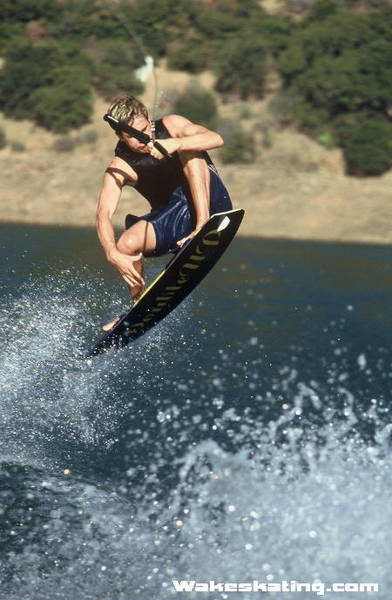
Another classic wakeskate wake-to-wake with a chopped down Double Up wakeboard from 1997.
So that was even farther down the road. When it first started, can you imagine, nobody except the pros wanted to mess up their wakeboards by putting something on their wakeboards that they couldnít take off. You know what Iím saying?
So it was just so natural to make bolt on traction pads because thatís what people wanted at that moment because that was an easy way to be able to try it. And those traction pads worked, and I was able to pretty much do anything I wanted to do on a wakeboard [laughs]. That was what was so great about it, you know? You could try all these new boards with different rocker lines and different sizes or whatever, and you could just bolt these pads onto any board and you could kind of feel it out. It was almost like a--they were a way to prototype the sport of wakeskating, you know? Traction pads were almost like the vehicle that allowed you to work on a board. You know what Iím saying?
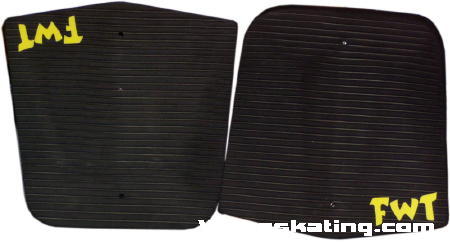
A set of Fresh Water Traction pads, complete with arch supports and kicktails (NOW you can rip).
You know, without kicktails, and concave, and a roughed up surface you could put your feet on, it was kind of hard to ride on these fiberglass boards. And then without that, it was kind of hard to figure out what boards worked good. So you had to start somewhere, and I decided to start with the traction pads.
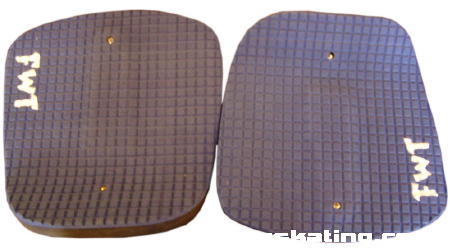
A later version of the Fresh Water Traction pad, which was designed to accomodate both barefooted riders and riders with shoes (notice the gap between the kicktail and the arch support).
WS: Plus itís a cheap way to get people involved in it. Theyíre not going to be afraid to drop $100.00 on an accessory like that.
J: Yeah, exactly. And that was always the intent of us, all of the insiders. We never had meetings or anything like that, but it was like these unspoken things that we always knew about wakeskating and we always talked about. You know, between Thomas, Josh and I, and Erich, we want to keep wakeskating cheap, we want to keep it accessible. We want to keep the product line so itís no bullshit, we want the products to work. We donít want the sport to get ruined in any way. We cared about the sport and thatís what made it really cool. People actually cared about the future of it. They actually cared about where it was going. And so with that, they were going to do what they could to make it right.
WS: Yeah, itís really inspiring to hear all of that. Iíve never heard that you guys kind of had a mild collaboration like that, and itís really good to hear that wakeskating was in such good hands early on. I think thatís why it has become as popular as it has in such a short amount of time. Granted, it has a long way to go, but you know, kids are getting psyched on it.
J: I didnít come from the wakeboarding background. I didnít come from the original dirty dozen or whatever. And I kind of liked having that invisible presence a little bit because wakeskating to me wasnít about one person or about one thing. It was going to take a collaboration of people to make it something, you know? Sure, it can mean something to you personally, and I had already held that close to me for three years. But when it was time to show other people and when it was time to let the sport be public and not underground anymore, it was really great to have that kind of feeling of, ďOh, itís away from me now and where it goes is where it goes.Ē You know, you didnít really take too much ownership into it [laughs]. And thatís what--you do what you can, you care for it how you can, and then you let it go. Kind of like a mother or something. You do the best you can to raise your kid, and then you just have to let it go [laughs].
WS: You were the first wakeskating company, whether it be boards or traction pads. Basically, the question was were people psyched on the idea or was there any opposition to what you were producing?
J: Yeah, the opposition was the unknown of how it was going to hurt people or how dangerous it was...yeah, that was kind of the big block at the beginning. Other than that, I think companies...if you saw me riding you kind of got it a little bit more.
But in some ways it took having to see someone else ride, or having to see someone else or seeing it in person to really get it [laughs]. 'Cause you tell a lot of people back then, you know, riding without bindings and theyíd just be like, ďThatís why we have bindings,Ē you know? ďWhy are you going back?Ē That was like a big thing; why ride without bindings when we finally have bindings. You know, kind of like, why are you gonna be old school. And it was more like, actually, no. Itís kind of a different experience.
And right at that time it was all about going big with wakeboarding. And it wasnít even about transition stuff, it was about landing in the flats, you know, loading your rope and stuff. So the style of riding for a lot of peopleĖnot everybody because there was a lot of good style riding going on in wakeboarding. But at the time, it was a little hard, I think, for a lot of people to conceive because the sport was already in this sort of ďgo big or go homeĒ kind of direction. And people werenít down with not going quite as big, is what it boiled down to [laughs].
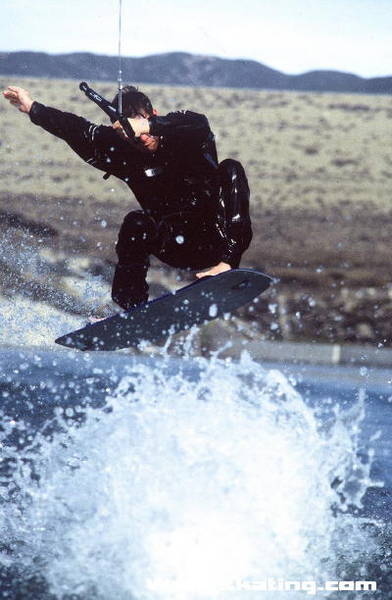
Jason riding his own way and still making it legit (WITHOUT bindings).
WS: Yeah, and it basically takes the person riding to understand what itís all about.
J: Yeah, it did. Exactly. It really did. Once people saw me ride or saw my video or some thing like that it was like, a great confusion just lifted off of them. It was like, oh, okay. I understand it now. I might not get it, but I understand it [laughs].
WS: So, why did you try to market products specifically for wakeskating? It was really underground at the timeÖ
J: Yeah, well, those were just the circles that I was in, just the underground. You know, I wasnít reallyĖon a day to day basis Iím not talking to mainstream big shops or anything. Iím talking to more people kind of like me, like smaller shops. And what I found out was, what makes good wakeskating is having the right fins, having the right type of traction on the top of your board, and the right board and just these kinds of things.
I just started making fins because there was no fins that were underĖyou know, Rainbow made an inch and a quarter fin that I rode a lot. But you know, there was no fins that were an inch at the time, so thatís why I made inch fins, Fresh Water Fins.
There just was no product out there that were real wakeskate products. So I just thought, of course I wanted to ride. It was basically like, how can I ride better. I just made products that helped me to ride better. Thatís just how it was. I wasnít wakeboarding. I stopped wakeboarding in '93 or whatever. I just stopped riding right after I started [laughs]. I seriously think my bindings broke after my first or second week on that board, and then I was just like, ďHmm, this isnít meĒ.
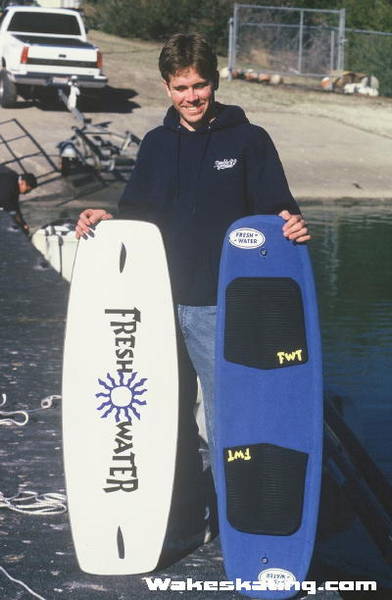
The famed Fresh Water Traction wakeskate...
WS: So like wakeskating, part of it for you was probably that the challenge was gratifying for you?
J: Yeah, definitely the challenge. But definitely just more pure for me, just like more from where Iím coming from. You have to understand, I was riding Burnside Project during the day, letís say, and then my dad would go out in the boat in the afternoon or something. So why would I go from skating this core, underground skate park to riding with bindings [laughs]? It was just like, ugh, it didnít really compute for me. But now I can see when you watch these good wakeboards, and how dangerous it is and what they can do. Itís really impressive.
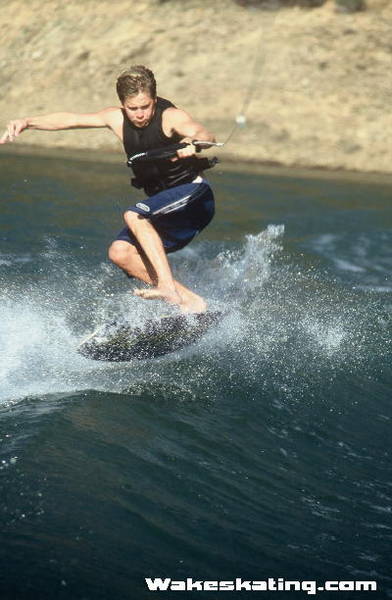
From the park to the water, a skate influenced inside out shuvit.
WS: So how did you know the industry was ready for a strictly wakeskating company? Or did you even care about that?
J: No, I had no idea. Not only did I not know, but I didnít even care. I knew that wakeskating was bigger than any company, was bigger than any initial reaction. Whatever was going on at that year in wakeskating didnít matter because I knew what was going to happen in the future. You know what Iím saying? When you know something so right, you donít even really...you donít put the brakes on. When you feel something right, you just go for it when your intuition tells you to. So I really wasnít listening to other companies, or I wasnít looking to see if my timing was right. All I knew was that this needed to come out, and people needed to start doing this and we need to start taking the sport in a good direction right now.
I went to Surf Expo in '96 and really the only other company I knew at the time was Double Up. That was Double Upís first year, too, at Surf Expo. And Josh was just around the corner at FM wakeboards, so I knew Josh. But I really just went to this Surf Expo pretty much not knowing anybody but Josh [laughs]. In fact, I met Collin on the flight over, you know, and his whole family, The Wrights, which are my really good friends now. I didnít really know the Smoked Monkeys board shop, and Iím flying over to Florida with them, and they didnít even know about my company or anything [laughs].
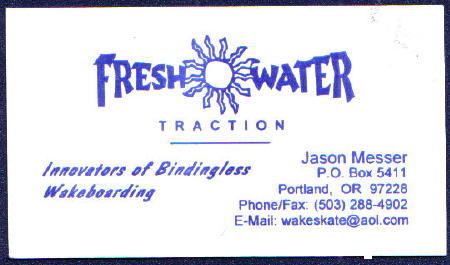
An original Fresh Water Traction business card. (With the recipient of said business card stating, "What's bindingless wakeboarding?")
You know, I didn't need to sell a bunch, and I didn't need to make other big companies see the light. It was more like, let me just touch the right people so they can help get this promoted and get this off in the right way. I think that was my goal at the trade show.
But you know, I knew going into that trade show that showing up to this trade show with traction pads that bolt onto the top of a wakeboard, that Iíd be lucky to get five people to understand it. And that kind of was true, with the shops at least that year. That year I really only had two distributors and one shop in--actually Marine Products in Salt Lake City was the only shop that sold an order with me at that trade show.
WS: Thatís unbelievable considering their location. Youíd think someone from California would have gotten it.
J: [Laughs] Yeah, I had already--I think that next summer, thatís when I started going up and down the west coast personally, selling them to shops. But at the time of the trade show, yeah, it was Marine Products--Jeremy. Jeremy at Marine Products saw the light that year. And then there was a couple other distributors, a U.K. distributor and a Japanese distributor that just kind of went.
WS: Thatís awesome that they got it overseas!
J: Yeah, you know, letís see..I think it was the next year I had sold one hundred pairs of traction pads to Japan. So there was way more wakeskating going on, and there were way more traction pads in Japan than there were in the US [laughs].
Okay, I have to switch back to the Surf Expo for one last question because you had mentioned something to me about Herbie Fletcher that I think is pretty interesting. What is the story behind your first Expo and your encounter with Herbie Fletcher?
J: For Surf Expo, I had barely got five pairs of traction pads made for the show. When I brought them down to the show, they were past the proto type phase. So I had made my jigs and I had all really nice cut stuff. I basically had to glue them that night before at like four in the morning, gluing pads together to get ready for the show.
And when I got to the trade show, they were all looking pretty good, but they werenít perfectly glued or anything [laughs]. I remember the last day of the trade show, I was just hanging out at my booth, and all of a sudden Herbie Fletcher comes up, and he just went right to a traction pad that was de-laming, and put his finger right in it and was like, errr, errr, rrrr, I can make these better. And he asked me, "Whoís making these for you?" You know, what factoryís making these for me? And I told him what my story was, and he started talking with me and heís like, "Boy, I didnít think this was coming for about 10 more years." And so I laughed and talked to him a little bit more. Ever since then, at all the trade shows Iíd always talk to Herbie and see whatís going on because heís always involved with wakeboarding. Heís just a pretty cool guy. I went down and met with him at his factory, checked out their whole operation and it was pretty impressive
I think that we even hammered out some prices, and thatís maybe why I met with him down there. And the traction pads that I was making were pretty labor intensive, and the way that Herbie would have made them would have been different and would have been a different lay-up process. And at the time, it just didnít seem like it was going to be cost effective to work with him.
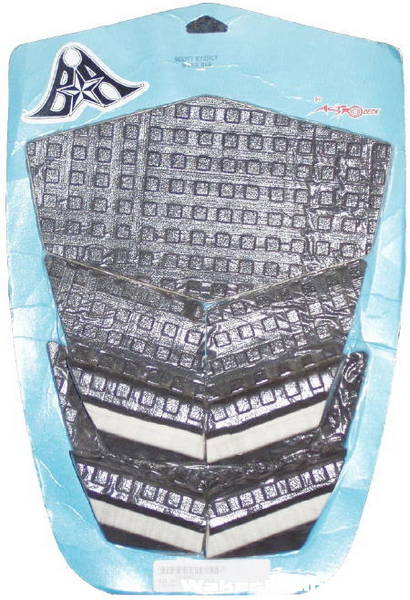
Known for their surf traction, Astrodeck would eventually develop their own traction for wakeskating under their "wake division" moniker, Bad Ass. Ultimately, this was their product--the Scott Byerly signature version.
Would those have cost more than the other ones?
J: No, because I knew that I couldnít beat a certain price. We would have always had to have kept them at about that price. I felt like it would have been a different product for the same price than what I would have made at that time.
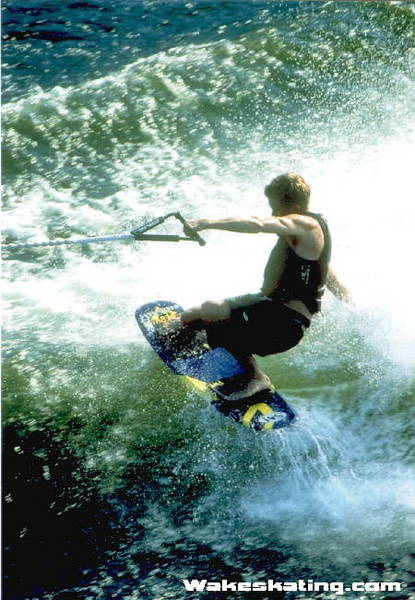
Legendary layback shot...
...
To proceed to the final section of the interveiw, click here.
Shop For Wakeskating Gear  CWB USCGA Boys Child Vest CWB USCGA Boys Child Vest
|
|

 Wakeboards Wakeboards
 Ronix Wakeboards Ronix Wakeboards
 Hyperlite Wakeboards Hyperlite Wakeboards
 Liquid Force Wakeboards Liquid Force Wakeboards
 Slingshot Wakeboards Slingshot Wakeboards
 CWB Wakeboards CWB Wakeboards
 Wakeboard Bindings Wakeboard Bindings
 Ronix Bindings Ronix Bindings
 Hyperlite Bindings Hyperlite Bindings
 Liquid Force Bindings Liquid Force Bindings
 Slingshot Bindings Slingshot Bindings
 CWB Bindings CWB Bindings
 Wakeboard Packages Wakeboard Packages
 Wakeskates Wakeskates
 Wakesurf Boards Wakesurf Boards
|